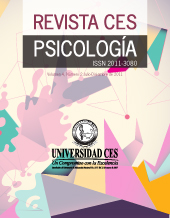Correlación del deseo sexual y disposición a fantasías sexuales con control inhibitorio y planificación cognitiva en jóvenes colombianos
DOI:
https://doi.org/10.21615/cesp.5512Palavras-chave:
deseo sexual diádico y solitario, deseo sexual inhibido, disposición a fantasías sexuales, control inhibitorio, planeación y solución de problemasResumo
Objetivo: El estudio se orientó a indagar la relación entre algunas funciones ejecutivas (FE) (control inhibitorio, cálculo de riesgo-beneficio, flexibilidad cognitiva, habilidad de planeación y toma de decisiones) con el deseo sexual general, diádico y solitario, inhibición del deseo sexual y disposición hacia las fantasías sexuales en una muestra de jóvenes entre 17 y 30 años. Método: Estudio de enfoque cuantitativo de corte transversal. Mediante un muestreo intencional por conveniencia se seleccionaron 64 jóvenes entre 17 y 30 años, estudiantes universitarios que se encontraban en una relación de pareja. Para evaluar las variables de las FE se utilizaron tareas de la Batería Neuropsicológica de Funciones Ejecutivas y Lóbulos Frontales (BANFE): Stroop, juego de cartas, clasificación de cartas y Torre de Hanoi, y las variables relacionadas con el deseo sexual fueron valoradas mediante el Test del Deseo Sexual Inhibido, el Inventario del Deseo Sexual (SDI-2, sigla de Sexual Desire Inventory) y la Escala de la Actitud hacia las Fantasías Sexuales. Resultados: Se encontraron correlaciones entre las variables del deseo sexual, disposición hacia las fantasías sexuales y el deseo sexual inhibido; deseo sexual total y diádico y disposición hacia las fantasías sexuales correlacionó con el control inhibitorio; y el deseo sexual inhibido correlacionó con la planificación y el control de impulsos. Discusión: Los hallazgos del estudio llaman la atención sobre las implicaciones educativas encaminadas a desarrollar las funciones ejecutivas en adolescentes y jóvenes con el fin prevenir conductas sexuales de riesgo.to formulate new hypotheses in the field of sexuality and neurosciences. The study findings draw attention to the educational implications aimed to develop the executive functions in adolescents and young people to prevent risky sexual behavior.
Downloads
Referências
Ardila, A. (2013). Executive Function [basics and evaluation]. Florida International University Miami, Florida, EE.UU, https://aalfredoardila.files.wordpress.com/2013/07/2013-ardila-funcic3b3n-ejecutiva-fundamentos-y-evaluacic3b3n.pdf
Ballester Brage, L., Orte Socías, C., & Pozo Gordaliza, R. (2014). Study of new pornography and sexual relations in youth. Andaluza Social Sciences Magazine, 13, 165-178. https://dx.doi.org/10.12795/anduli.2014.i13.10
Baumeister, R.F. (2000). Gender differences in erotic plasticity: the female sex drive as socially flexible and responsive. Psychological Bulletin, 126(3), 347–374. https://pubmed.ncbi.nlm.nih.gov/10825779/
Baumeister R., Catanese K., & Vohs K. (2001). Is there a gender difference in strength of sex drive? Theoretical views, conceptual distinctions, and a review of relevant evidence. Personality Social Psychology Review, 5(3), 242–273. https://doi.org/10.1207/S15327957PSPR0503_5
Bernal-Pacheco, O., Vega-Rincón, M., & Hernández-Preciado, J. (2009). Neuropsychiatric Consequences of cranioencephalic trauma. Journal of medical faculty, 17(1), 65-74. http://www.scielo.org.co/pdf/med/v17n1/v17n1a10.pdf
Broverman, D., Klaiber, E., & Kobayahi, Y. (1968). Roles of activation and inhibition in sex differences in cognitive abilities. Psychological Review, 75(3), 259-259. http://dx.doi.org/10.1037/h0020280
Cacioppo, S., Bianchi-Demicheli, F., Frum, C., Pfaus, J.G., & Lewis, J.W. (2012). The common neural bases between sexual desire and love: A multilevel kernel density fMRI analysis. Journal Sexual Medicine, 12(9), 1048–1054. http://dx.doi.org/10.1111/j.1743-6109.2012.02651.x
Cabrera, V., Salazar, P., Docal, M., Aya, V., Ardila, M., & Rivera, R. (2013). Lifestyle of the youth and the needs for a sexual education. Bogotá: Editorial IEMP.
Calero, E., Rodríguez, S., & Trumbull, A. (2017). Approach to sexuality in adolescence. Medical human sciences, 17(3), 577-592. http://scielo.sld.cu/scielo.php?script=sci_arttext&pid=S1727-81202017000300010&lng=es&tlng=es
Colegio Colombiano de Psicólogos. (2009). Deontología y bioética del ejercicio de la psicología en Colombia. Bogotá: Javegraf. https://www.infopsicologica.com/documentos/2009/Deontologia_libro.pdf
Collins, W. A. (2003). More than myth: the developmental significance of romantic relationships during adolescence. Journal of Research on Adolescence, 13, 1-24. http://dx.doi.org/10.1111/1532-7795.1301001
Contreras, P., Guzmán, M., Alfaro, C., & Jiménez, P. (2011). Meanings associated with infidelity in university students with secure and insecure attachment style. Health and society, 2(1), 10-30. https://doi.org/10.22199/S07187475.2011.0001.00001
Dawson, S., & Chivers, M. (2014). Gender Differences and Similarities in Sexual Desire. Current Sexual Health Reports, 6(4), 211-219. https://doi.org/10.1007/s11930-014-0027-5
Desvarieux, A., Salamanca, Y., Ortega, V., & Sierra, J. (2005). Validation of the spanish version of the Hurlbert Index of Sexual Fantasy: a measure of the attitude towards sexual fantasies. Mexican magazine of Psychology, 22(2), 529-539. http://www.redalyc.org/pdf/2430/243020634016.pdf
De la Cruz, C., & Fernández-Cuesta, M. (2014). Sexuality in adolescents and youth. En AEPap (edit). Update course on Pediatrics. Madrid: Exlibris Ediciones, p. 257-263. http://cursosaepap.exlibrisediciones.com/files/49-215-fichero/La%20sexualidad%20en%20adolescentes.pdf
Echeburúa, E. (2012). Does sex addiction really exist? Addictions, 24(4), 281-285, http://www.redalyc.org/pdf/2891/289124639001.pdf
Egea, S. (2016). The sexuality experience in adolescence. Psicosomatic medicine magazine, 118, 71-79, https://dialnet.unirioja.es/descarga/articulo/5567812.pdf
Ellis, B. J., & Symons, D. (1990). Sex differences in sexual fantasy: An evolutionary psychological approach. Journal of Sex Research, 27(4), 527–555. http://dx.doi.org/10.1080/00224499009551579
Erikson, E. (1986). Childhood and society. Buenos Aires: Editorial Paidos.
Escalante-Romero, L., Cerrón-Vela, C., Salazar-Granara, A., & Mezones-Holguín, E. (2008). Description of the sexual conduct in young adults from Lima. Medical Horizon, 8(1), 73-80. https://www.redalyc.org/pdf/3716/371637117005.pdf
Flores, J., Ostrozky, F., & Lozano, A. (2014). BANFE. Manual of neuropsycological collection of Executive Functions and Frontal Lobes. México: Modern Manual.
Fuertes, A., & López, F. (1997). Approach to the study of sexuality. Salamanca: Amarú
Garza, I. (2010). Neurobiología del amor. El Residente, 5(1), 6-8. https://www.medigraphic.com/pdfs/residente/rr-2010/rr101b.pdf
Hurlbert, D., & Apt, C. (1993). Female sexuality: A comparative study between women in homosexual and heterosexual relationships. Journal of Sex and Marital Therapy, 19, 315-327. https://dx.doi.org/10.1080/00926239308404375
Johnson, S., Blum, R., & Giedd, J. (2009). Adolescent Maturity and the Brain: The Promise and Pitfalls of Neuroscience Research in Adolescent Health Policy. Journal of Adolescent Health, 45(3), 216–221. http://dx.doi.org/10.1016/j.jadohealth.2009.05.016
Kawabata, H., & Zeki, S. (2008). The Neural Correlates of Desire. PLoS ONE, 3(8), e3027. https://doi.org/10.1371/journal.pone.0003027
Laier, C., Pawlikowski, M., & Brand, M. (2014). Sexual picture processing interferes with decision-making under ambiguity. Arch Sex Behaviour, 43, 473–482. http://dx.doi.org/10.1007/s10508-013-0119-8
Leitenberg, H., & Henning, K. (1995). Sexual fantasy. Psychological Bulletin, 117(3), 469-496. http://dx.doi.org/10.1037/0033-2909.117.3.469
Masters, W., Johnson, V., & Kolodny, R. (1994). Heterosexuality. Nueva York: Harper Collins Publishers. (Trad. Grijalbo, 1996).
Messina, B., Fuentes, D., Tavares, H., Abdo, C., & Scanavino, M. (2017). Executive Functioning of Sexually Compulsive and Non-Sexually Compulsive Men Before and After Watching an Erotic Video. Journal Sexual Medicine, 14, 347–354. http://dx.doi.org/10.1016/j.jsxm.2016.12.235
Miner, M., Raymond, N., Mueller, B., Lloyd, M., & Lim, K. (2009). Preliminary investigation of the impulsive and neuroanatomical characteristics of compulsive sexual behavior. Psychiatry Researche, 174, 146–151. http://dx.doi.org/10.1016/j.pscychresns.2009.04.008
Morse, W. (1985). Inhibited Sexual Desire and Sexual Avoidance. Can Fam Physician, 31, 781–786. https://www.ncbi.nlm.nih.gov/pmc/articles/PMC2327527/
Mulhauser, K., Struthers, W., Hook, J., Pyykkonen, B., Womack, S., & MacDonald, M. (2014). Performance on the Iowa Gambling Task in a sample of hypersexual men. Sex Addict Compuls, 21, 170–183. http://dx.doi.org/10.1080/10720162.2014.908333
Nutter, D., & Condron, M. (1983). Sexual fantasy and activity patterns of females with inhibited sexual desire versus normal controls. Journal of Sex Marital Therapy, 9(4), 276-282. http://dx.doi.org/10.1080/00926238308410914
Nutter, D., & Condron, M. (1985). Sexual Fantasy and Activity Patterns of Males with Inhibited Sexual Desire and Males with Erectile Dysfunction versus Normal Controls. Journal of Sex and Marital Therapy, 11(2), 91-98. http://dx.doi.org/10.1080/00926238508406074
Ortigue, S., Bianchi-Demicheli, F., Patel, N., Frum, C., & Lewis, J. (2010). Neuroimaging of love: fMRI meta-analysis evidence toward new perspectives in sexual medicine. Journal Sexual Medicine, 7, 3541–3552. http://dx.doi.org/10.1111/j.1743-6109.2010.01999.x
Regan, P., & Atkins, L. (2006). Gender differences and similarities in the frequency and intensity of sexual desire. Social behaviour and personality: International Journal 34, 95-102. https://doi.org/10.2224/sbp.2006.34.1.9
Reid, R., Karim, R., McCrory, E., & Carpenter, B. (2010). Self-reported differences on measures of executive function and hypersexual behavior in a patient and community sample of men. Int J Neurosci, 120, 120–127. http://dx.doi.org/10.3109/00207450903165577
Reid, R., Garos, S., Carpenter, B., & Coleman, E. (2011). A surprising finding related to executive control in a patient sample of hypersexual men. Journal Sexual Medicine, 8, 2227–2236. http://dx.doi.org/10.1111/j.1743-6109.2011.02314.x
Rojas-Solís, J., & Flores, A. (2013). Courtship and other emotional links of the Mexican youth in a society with post-modern characteristics. Uaricha, 10(23), 120-139. https://www.aacademica.org/dr.jose.luis.rojas.solis/13.pdf
Sáez, I., & Guijarro, C. (2016). Attitudes and sexual experience in young women. http://cogprints.org/5382/1/Sexualidad_Euskadi.pdf
Sebastián, M. (2015). Couple relationship in free union: case study. http://www.ucb.edu.bo/publicaciones/Ajayu/v14n2/v14n2a8.pdf
Sierra, J., Vera-Villarroel, P., & Martín-Ortiz, J. (2002). Sexual conducts, sexual satisfaction and sexual fantasies: gender and nationality differences. Latinamerican advances in clinical psychology, 20, 57-62.
Sierra, J., Zubeidat, I., Carretero-Dios, H., & Reina, S. (2003). Preliminar psychosometric study of the Inhibited Sexual Desire Test in a Spanish non-clinic sample. International Journal of Clinical and Health Psychology, 3(3), 489-504. http://aepc.es/ijchp/articulos_pdf/ijchp-84.pdf
Sierra, J.C., Perla, F., & Gutiérrez-Quintanilla, R. (2010). Attitude towards masturbation in adolescents: psychometric properties of the Spanish version of Attitudes Toward Masturbation Inventory. Universitas Psychologica, 9(2), 531-542. http://www.scielo.org.co/pdf/rups/v9n2/v9n2a19.pdf
Santos-Iglesias, P., Calvillo, G., & Sierra, J. (2011). A further examination of Levine's model of sexual desire. Psychology & Sexuality, 4(1), 34-45. http://dx.doi.org/10.1080/19419899.2011.576697
Seok, J-W., & Sohn, J-H. (2015). Neural Substrates of Sexual Desire in Individuals with Problematic Hypersexual Behavior. Front. Behav. Neurosci. 9, 321. http://dx.doi.org/10.3389/fnbeh.2015.00321
Simons, J., & Carey, M. (2001). Prevalence of sexual dysfunctions: Results from a decade of research. Archives of Sexual Behavior, 30(2), 177-219. https://doi.org/10.1023/A:1002729318254
Spector, I., & Fremeth, S. (1996). Sexual behaviors and attitudes of geriatric residents in long-term care facilities. Journal of Sex and Marital Therapy, 22(4), 235-246. http://dx.doi.org/10.1080/00926239608404402
Spector, I., Carey, M., & Steinberg, L. (1996). The Sexual Desire Inventory: Development, factor structure, and evidence of reliability. Journal of Sex and Marital Therapy, 22(3), 175-190. http://dx.doi.org/10.1080/00926239608414655
Sylva, D., Safron, A., Rosenthal, A., Reber, P., Parrish, T., & Bailey, J. (2013). Neural correlates of sexual arousal in heterosexual and homosexual women and men. Horm Behav, 64(4), 673-84. http://dx.doi.org/10.1016/j.yhbeh.2013.08.003
Štulhofer, A., Bergeron, S., & Jurin, T (2016). Is High Sexual Desire a Risk for Women's Relationship and Sexual Well-Being? J Sex Res, 53(7), 882-91. http://dx.doi.org/10.1080/00224499.2015.1084984
Thornton, A., & Young-DeMarco, L. (2001). Four decades of trends in attitudes toward family. Issues in the United States: he 1960’s hrough the 1990’s. Journal of Marriage and the Family, 63, 1009-1037, https://doi.org/10.1111/j.1741-3737.2001.01009.x
Voon, V., Mole, T., Banca, P., Porter, L., Morris, L., Mitchell, S., Lapa, T., Karr, J., Harrison, N., Potenza, M., & Irvine, M. (2014). Neural Correlates of Sexual Cue Reactivity in Individuals with and without Compulsive Sexual Behaviours. PLoS ONE, 9(7), e102419. http://doi.org/10.1371/journal.pone.0102419
War, F., Jamuna, R., & Arivazhagan, A. (2014). Cognitive and sexual functions in patients with traumatic brain injury. Asian Journal of Neurosurgery, 9(1), 29–32. http://doi.org/10.4103/1793-5482.131061
Wilson G., & Lang R. (1981). Sex differences in sexual fantasy patterns. Personality & Individual Differences, 2(4), 343-346. http://dx.doi.org/10.1016/0191-8869(81)90093-3
Yyuan, J., He, Y., Qinglin, Z., Chen, A., & Li, H. (2008). Gender differences in behavioral inhibitory control: ERP evidence from a two-choice oddball task. Psychophysiology, 45(6), 986-93. http://dx.doi.org/10.1111/j.1469-8986.2008.00693.x
Zubeidat, I., Ortega, V., del Villar, C., & Sierra, J. (2003). A study about the implications of the sexual attitudes and fantasies in sexual desire in adolescents. Psychosomatic medicine and psychiatry Magazine, 67/68, 71-78. http://www.editorialmedica.com/download.php?idart=163
Zubeidat, I., Ortega, V., & Sierra, J. C. (2004). Evaluation of some determining factors of sexual desire: emotional state, sexual attitudes and sexual fantasies. Analysis and conduct modification, 30(129), 105-128. https://dialnet.unirioja.es/servlet/articulo?codigo=856927
Downloads
Publicado
Como Citar
Edição
Seção
Licença
Copyright (c) 2021 CES Psicología

Este trabalho está licenciado sob uma licença Creative Commons Attribution-NonCommercial-ShareAlike 4.0 International License.
Revista CES Psicología ISSN 2011 3080
Facultad de Psicología, Universidad CES Primera edición 2008. Última actualización Mayo 18 de 2022. Todos los derechos reservados. Hecho el depósito legal que exige la ley.
Se autoriza la reproducción total o parcial de los artículos citando la fuente y el autor. This publication may be reproduced by mentioning the source and the authors.
| Métricas do artigo | |
|---|---|
| Vistas abstratas | |
| Visualizações da cozinha | |
| Visualizações de PDF | |
| Visualizações em HTML | |
| Outras visualizações | |




